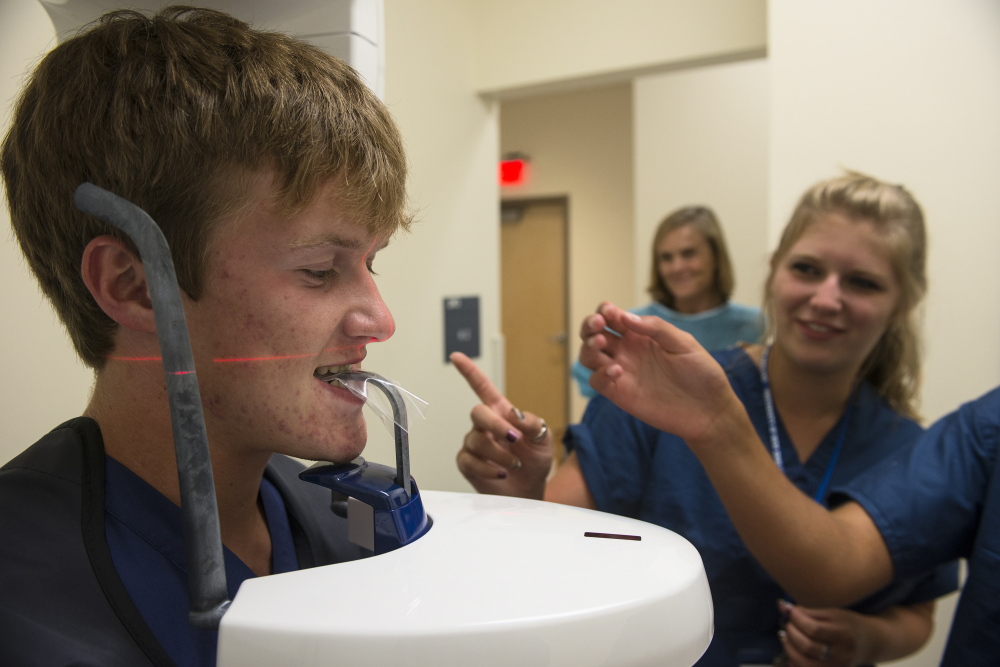Greta Castonguay is the type of student the University of New England’s new dental school wants — a homegrown talent who would consider opening a practice in rural or small-town Maine after graduation.
“I don’t mind small towns. I grew up in one,” the 19-year-old Castonguay said.
The Turner resident volunteered at the school’s “dentist camp” on Monday, an event intended to encourage high school students to consider a career in dentistry in Maine.
One of the primary missions of the dental school, which opened in 2013, is to reverse the shortage of dentists in rural parts of the state, a trend that is expected to worsen, school officials say.
At the camp, teenagers filled cavities in mannequins, took X-rays and worked on teeth moldings.
Dr. Jeffrey Doss, an oral surgeon who owns a practice in four Maine towns, including South Portland, showed the students how to suture chicken breasts, which closely resemble the inside of a human mouth. In dentistry, Doss said, the sutures might be used to stem bleeding after removing wisdom teeth, or to repair a split lip.
“That’s right, you nailed it,” Doss told Amber Ivey, a 16-year-old Houlton High School junior, after she completed a stitching.
The technique requires a steady hand.
“I liked it,” Ivey said, “but I got frustrated because I’m not used to doing the sutures.”
One of 18 high school students at the camp, Ivey is considering a career in dentistry because she finds the field interesting and “there’s not a lot of dentists in Maine.”
Maine has 50 dentists per 100,000 people, compared to the national average of 61, according to America’s Health Rankings, a website that collects data on the health industry.
And dentists are not spread out evenly in the state. Most rural counties have half as many, or fewer, practicing dentists per capita as Cumberland County, which has 76 practicing for every 100,000 people. In Somerset County, for example, there are only 17 dentists per 100,000. Rural dentists also are older, averaging nearly 60 years old.
Castonguay is a sophomore at Susquehanna University in Pennsylvania, and she hopes to get into the University of New England dental school after earning her undergraduate degree. Eventually, she wants to open a practice in Maine, perhaps not far from her hometown.
Northern New England’s only dental school holds spots open for applicants from Maine, New Hampshire and Vermont, said Dr. Jon Ryder, assistant dean for academic affairs. Also, all applications from northern New England are reviewed, while students from outside the region may not be considered if they don’t meet certain criteria, such as not having a high enough grade-point average.
Ryder said the hope is that Mainers will stick around after graduation to open practices here.
“Mainers tend to want to stay in Maine and stay near their original hometown,” said Ryder, noting that 25 percent of the school’s inaugural class of 64 students hails from Maine.
Fourth-year students will intern across the state and in New Hampshire and Vermont, including at community clinics, private practices and the Veterans Affairs Medical Center in Togus, giving students experience both in treating patients and in living in the less-populated areas that need dentists.
Dr. Jonathan Shenkin, an Augusta dentist and representative for the Maine Dental Association, said while the dental school is helpful, it doesn’t address the underlying causes of the shortage in rural Maine.
“The biggest issue is not the availability of dentists, but that people can’t afford dental care,” Shenkin said, explaining that Maine does not cover adult dental care under MaineCare, the state’s Medicaid program. About half of all states provide a Medicaid dental benefit for adults.
A bill to allow MaineCare adults one free dental cleaning per year died in the Legislature this year, as did a proposal to increase MaineCare reimbursements to dentists for pediatric care. Only about half of all dentists accept MaineCare patients.
Shenkin said a state-funded tax credit or loan forgiveness program for dentists who recently graduated from dental school also would help, as new dentists can carry debt loads of $200,000 or more. Tuition at the University of New England’s dental school is about $56,000 per year.
Maine voters approved a $5 million bond in 2010 to help finance the dental school, but Shenkin said without the state solving other pieces of the fiscal puzzle, the dentist shortage will persist. The Legislature this year approved a new category of dental provider — the midlevel dental therapist — touted as a way to address the shortage of dentists. The dental therapist would be similar to a nurse practitioner. However, a nurse practitioner can operate independently, while the new dental therapist would have to work in the same office as a dentist, which some experts say reduces the effectiveness of having dental therapists. The therapists can perform some of the duties of a dentist, such as filling routine cavities.
The Board of Dental Examiners is charged with developing educational standards in 2015 so that local colleges and universities can start dental therapist programs.
For University of New England dental school student Shilo Annis of Windham, the tug of his home state is strong. Despite traveling the world as a pilot with the Army and the U.S. Customs and Border Protection, he wanted to switch careers in part to come home to Maine.
Annis, 36, on Monday showed camp participants how to fill cavities on a mannequin. Once he graduates from dental school in two years, Annis hopes to set up a practice in Limington, where he lives with his wife and young child.
“Maine’s home, and I want to stay here now,” Annis said. “I’m not much of a city person.”
Joe Lawlor — 791-6376
jlawlor@pressherald.com
Twitter: @joelawlorph
Send questions/comments to the editors.




